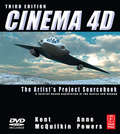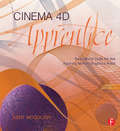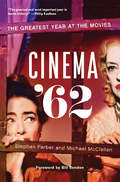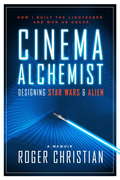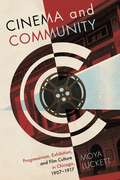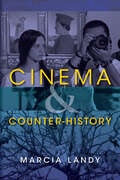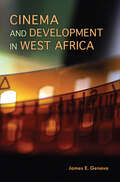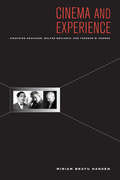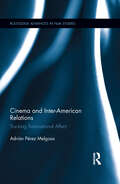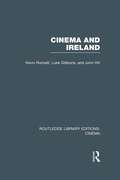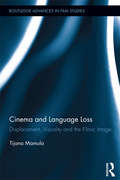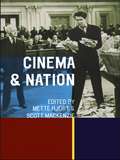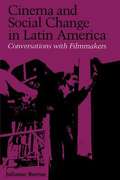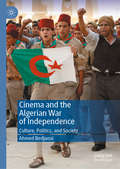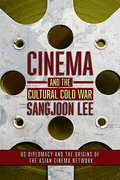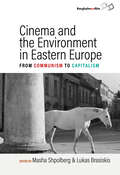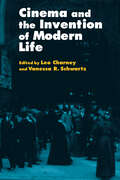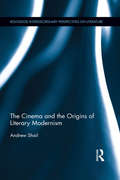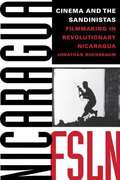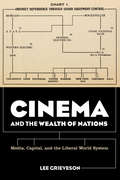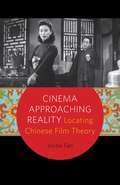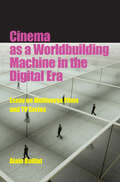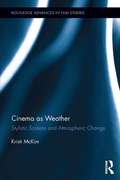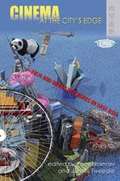- Table View
- List View
CINEMA 4D: The Artist's Project Sourcebook
by Kent McQuilkin Anne PowersMake the creative leap to 3D. Realize your artistic vision with this treasure chest of instructional, practical projects. Get the essential concepts and techniques without drowning in the technical complexities.
Cinema 4D Apprentice: Real-World Skills for the Aspiring Motion Graphics Artist (Apprentice Series)
by Kent McQuilkinNew to CINEMA 4D and looking for an accessible way to get up to speed quickly? Do you already know the basics of the software but need to know the new features or take your skills and understanding a little deeper? If so, look no further than CINEMA 4D Apprentice, your one-stop shop for learning this powerful application. With guidance that takes you beyond just the button-pushing, author Kent McQuilkin guides you through 10 core lessons, starting with the basics before moving onto more complex techniques and concepts and then tying it all together with a final project. CINEMA 4D Apprentice walks you through the software with a project-based approach, allowing you to put lessons learned into immediate practice. Best practices and workflows for motion graphics artists that can be applied to any software application are included. A companion website (www.focalpress.com/cw/mcquilkin) features project files and videos of the techniques in action. Topics covered include: creating basic scenes, modeling, texture mapping mograph in-depth integration with After Effects via CINEWARE lighting, animation, rendering and more motion tracking with the new tools included in R16
Cinema '62: The Greatest Year at the Movies
by Stephen Farber Michael McClellanLawrence of Arabia, The Miracle Worker, To Kill a Mockingbird, The Manchurian Candidate, Gypsy, Sweet Bird of Youth, The Longest Day, The Music Man, What Ever Happened to Baby Jane, and more. Most conventional film histories dismiss the early 1960s as a pallid era, a downtime between the heights of the classic studio system and the rise of New Hollywood directors like Scorsese and Altman in the 1970s. It seemed to be a moment when the movie industry was floundering as the popularity of television caused a downturn in cinema attendance. Cinema ’62 challenges these assumptions by making the bold claim that 1962 was a peak year for film, with a high standard of quality that has not been equaled since. Stephen Farber and Michael McClellan show how 1962 saw great late-period work by classic Hollywood directors like John Ford, Howard Hawks, and John Huston, as well as stars like Bette Davis, James Stewart, Katharine Hepburn, and Barbara Stanwyck. Yet it was also a seminal year for talented young directors like Sidney Lumet, Sam Peckinpah, and Stanley Kubrick, not to mention rising stars like Warren Beatty, Jane Fonda, Robert Redford, Peter O’Toole, and Omar Sharif. Above all, 1962—the year of To Kill a Mockingbird and The Manchurian Candidate—gave cinema attendees the kinds of adult, artistic, and uncompromising visions they would never see on television, including classics from Fellini, Bergman, and Kurosawa. Culminating in an analysis of the year’s Best Picture winner and top-grossing film, Lawrence of Arabia, and the factors that made that magnificent epic possible, Cinema ’62 makes a strong case that the movies peaked in the Kennedy era.
Cinema Alchemist: Designing Star Wars and Alien
by Roger ChristianFor the first time, Oscar-winning production designer and director Roger Christian reveals his life story, from his earliest work in the British film industry to his breakthrough contributions on such iconic science fiction masterpieces as Star <P> Wars, Alien and his own rediscovered Black Angel.This candid biography delves into his relationships with legendary figures, as well as the secrets of his greatest work. The man who built the lightsaber finally speaks!
Cinema and Censorship: The Politics of Control in India
by Someswar BhowmikThis 'narrative historiography' traces the evolution of censorship discourses in post-colonial India, delineates the theoretical bases of censorship claims and contentions, and uncovers its many socio-political dimensions and complexities.
Cinema and Community: Progressivism, Exhibition, and Film Culture in Chicago, 1907-1917
by Moya LuckettCaught between the older model of short film and the emerging classic era, the transitional period of American cinema (1907-1917) has typically posed a problem for studies of early American film. Yet in Cinema and Community: Progressivism, Exhibition, and Film Culture in Chicago, 1907-1917, author Moya Luckett uses the era's dominant political ideology as a lens to better understand its cinematic practice. Luckett argues that movies were a typically Progressive institution, reflecting the period's investment in leisure, its more public lifestyle, and its fascination with celebrity. She uses Chicago, often considered the nation's most Progressive city and home to the nation's largest film audience by 1907, to explore how Progressivism shaped and influenced the address, reception, exhibition, representational strategies, regulation, and cultural status of early cinema. After a survey of Progressivism's general influences on popular culture and the film industry in particular, she examines the era's spectatorship theories in chapter 1 and then the formal characteristics of the early feature film-including the use of prologues, multiple diegesis, and oversight-in chapter 2. In chapter 3, Luckett explores the period's cinema in the light of its celebrity culture, while she examines exhibition in chapter 4. She also looks at the formation of Chicago's censorship board in November 1907 in the context of efforts by city government, social reformers, and the local press to establish community standards for cinema in chapter 5. She completes the volume by exploring race and cinema in chapter 6 and national identity and community, this time in relation to World War I, in chapter 7. As well as offering a history of an underexplored area of film history, Luckett provides a conceptual framework to help navigate some of the period's key issues. Film scholars interested in the early years of American cinema will appreciate this insightful study.
Cinema and Counter-History
by Marcia LandyDespite claims about the end of history and the death of cinema, visual media continue to contribute to our understanding of history and history-making. In this book, Marcia Landy argues that rethinking history and memory must take into account shifting conceptions of visual and aural technologies. With the assistance of thinkers such as Gilles Deleuze and Félix Guattari, Cinema and Counter-History examines writings and films that challenge prevailing notions of history in order to explore the philosophic, aesthetic, and political stakes of activating the past. Marshaling evidence across European, African, and Asian cinema, Landy engages in a counter-historical project that calls into question the certainty of visual representations and unmoors notions of a history firmly anchored in truth.
Cinema and Development in West Africa
by James E. GenovaCinema and Development in West Africa shows how the film industry in Francophone West African countries played an important role in executing strategies of nation building during the transition from French rule to the early postcolonial period. James E. Genova sees the construction of African identities and economic development as the major themes in the political literature and cultural production of the time. Focusing on film both as industry and aesthetic genre, he demonstrates its unique place in economic development and provides a comprehensive history of filmmaking in the region during the transition from colonies to sovereign states.
Cinema and Experience
by Edward Dimendberg Miriam Bratu HansenSiegfried Kracauer, Walter Benjamin, and Theodor W. Adorno--affiliated through friendship, professional ties, and argument--developed an astute philosophical critique of modernity in which technological media played a key role. This book explores in depth their reflections on cinema and photography from the Weimar period up to the 1960s. Miriam Bratu Hansen brings to life an impressive archive of known and, in the case of Kracauer, less known materials and reveals surprising perspectives on canonic texts, including Benjamin's artwork essay. Her lucid analysis extrapolates from these writings the contours of a theory of cinema and experience that speaks to questions being posed anew as moving image culture evolves in response to digital technology.
Cinema and Inter-American Relations: Tracking Transnational Affect (Routledge Advances in Film Studies)
by Adrián Pérez MelgosaCinema and Inter-American Relations studies the key role that commercial narrative films have played in the articulation of the political and cultural relationship between the United States and Latin America since the onset of the Good Neighbor policy (1933). Pérez Melgosa analyzes the evolution of inter-American narratives in films from across the continent, highlights the social effects of the technologies used to produce these works, and explores the connections of cinema to successive shifts in hemispheric policy. As a result, Cinema and Inter-American Relations reveals the existence of a continued cinematic conversation between Anglo and Latin America about a cluster of shared allegories representing the continent and its cultures. Pérez Melgosa contends that cinema has become a virtual contact zone of the Americas, mediating in a variety of hemispheric political debates about the articulation of Anglo, Latin American, and Latino identities. Cinema and Inter-American Relations brings sustained attention to ongoing calls for a transnational focus on the disciplines of film studies, American studies, and Latin American studies and engages with current theories of the transmission of affect to delineate a new cartography of how to understand the Americas in relation to cinema.
Cinema and Ireland: Film, Culture And Politics (Routledge Library Editions: Cinema)
by Kevin Rockett Luke Gibbons John HillThis was the first comprehensive study of film production in Ireland from the silent period to the present day, and of representations of Ireland and ‘Irishness’ in native, British, and American films. It remains an authority on the topic. The book focuses on Irish history and politics to examine the context and significance of such films as Irish Destiny, The Quiet Man, Ryan’s Daughter, Man of Aran, Cal, The Courier, and The Dead.
Cinema and Language Loss: Displacement, Visuality and the Filmic Image (Routledge Advances in Film Studies)
by Tijana MamulaCinema and Language Loss provides the first sustained exploration of the relationship between linguistic displacement and visuality in the filmic realm, examining in depth both its formal expressions and theoretical implications. Combining insights from psychoanalysis, philosophy and film theory, the author argues that the move from one linguistic environment to another profoundly destabilizes the subject’s relation to both language and reality, resulting in the search for a substitute for language in vision itself – a reversal, as it were, of speaking into seeing. The dynamics of this shift are particularly evident in the works of many displaced filmmakers, which often manifest a conflicted interaction between language and vision, and through this question the signifying potential, and the perceptual ambiguities, of cinema itself. In tracing the encounter between cinema and language loss across a wide range of films – from Billy Wilder’s Sunset Boulevard to Chantal Akerman’s News from Home to Michael Haneke’s Caché – Mamula reevaluates the role of displacement in postwar Western film and makes an original contribution to film theory and philosophy based on a reconsideration of the place of language in our experience and understanding of cinema.
Cinema and Nation
by Mette Hjort Scott MacKenzieIdeas of national identity, nationalism and transnationalism are now a central feature of contemporary film studies, as well as primary concerns for film-makers themselves. Embracing a range of national cinemas including Scotland, Poland, France, Turkey, Indonesia, India, Germany and America, Cinema and Nation considers the ways in which film production and reception are shaped by ideas of national belonging and examines the implications of globalisation for the concept of national cinema.In the first three Parts, contributors explore sociological approaches to nationalism, challenge the established definitions of 'national cinema', and consider the ways in which states - from the old Soviet Union to contemporary Scotland - aim to create a national culture through cinema. The final two Parts address the diverse strategies involved in the production of national cinema and consider how images of the nation are used and understood by audiences both at home and abroad.
Cinema and Social Change in Latin America: Conversations with Filmmakers
by Julianne BurtonSince the late 1960s, films from Latin America have won widening audiences in North America and Europe. Until now, no single book has offered an introduction to the diverse personalities and practices that make up this important regional film movement. In Cinema and Social Change in Latin America, Julianne Burton presents twenty interviews with key figures of Latin American cinema, covering three decades and ranging from Argentina to Mexico. Interviews with pioneers Fernando Birri, Nelson Pereira dos Santos, and Glauber Rocha, renowned feature filmmakers Tomás Gutiérrez Alea and Carlos Diegues, prize-winning documentarists Patricio Guzmán and Helena Solberg-Ladd, among others, endeavor to balance personal achievement against the backdrop of historical, political, social, and economic circumstances that have influenced each director''s career. Presented also are conversations that cast light on the related activities of acting, distribution, theory, criticism, and film-based community organizing. More than their counterparts in other regions of the world, Latin American artists and intellectuals acknowledge the degree to which culture is shaped by history and politics. Since the mid-1950s, a period of rising nationalism and regional consciousness, talented young artists and activists have sought to redefine the uses of the film medium in the Latin American context. Questioning the studio and star systems of the Hollywood industrial model, these innovators have developed new forms, content, and processes of production, distribution, and reception. The specific approaches and priorities of the New Latin American Cinema are far from monolithic. They vary from realism to expressionism, from observational documentary to elaborate fictional constructs, from "imperfect cinema" to a cinema that emulates the high production values of the developed sectors, from self-reflexive to "transparent" cinematic styles, from highly industrialized modes of production to purely artisanal ones. What does not vary is the commitment to film as a vehicle for social transformation and the expression of national and regional cultural autonomy. From early alternative cinema efforts in Argentina, Brazil, and Cuba to a contemporary perspective from within the Mexican commercial industry to the emerging cinema and video production from Central America, Cinema and Social Change in Latin America offers the most comprehensive look at Latin American film available today. Since the late 1960s, films from Latin America have won widening audiences in North America and Europe. Until now, no single book has offered an introduction to the diverse personalities and practices that make up this important regional film movement. In Cinema and Social Change in Latin America, Julianne Burton presents twenty interviews with key figures of Latin American cinema, covering three decades and ranging from Argentina to Mexico. Interviews with pioneers Fernando Birri, Nelson Pereira dos Santos, and Glauber Rocha, renowned feature filmmakers Tomás Gutiérrez Alea and Carlos Diegues, prize-winning documentarists Patricio Guzmán and Helena Solberg-Ladd, among others, endeavor to balance personal achievement against the backdrop of historical, political, social, and economic circumstances that have influenced each director''s career. Presented also are conversations that cast light on the related activities of acting, distribution, theory, criticism, and film-based community organizing. More than their counterparts in other regions of the world, Latin American artists and intellectuals acknowledge the degree to which culture is shaped by history and politics. Since the mid-1950s, a period of rising nationalism and regional consciousness, talented young artists and activists have sought to redefine the uses of the film medium in the Latin American context. Questioning the studio and star systems of the Hollywood industrial model, these innovators have developed new forms, content, and processes of production, distribution, and reception. The specific approach...
Cinema and the Algerian War of Independence: Culture, Politics, and Society (Palgrave Studies in Arab Cinema)
by Ahmed BedjaouiThe book examines the war of images between France and Algeria. Discussing the role of the United States during the war, it covers topics such the presence of American reporters in Algeria, John F. Kennedy’s support for Algerian independence while a senator, the broadcasting of documentaries on the Algerian war on public television, and reporting in the press. Even half a century after Algerian independence, there remains a need for both film and literature on the war from both sides of the Mediterranean. This might seem surprising, particularly to media professionals, given the quantity of output on the subject, but both French and Algerian portrayals of the war remain flawed and shackled to their respective ideologies.The generation of FLN leaders recognized early on the importance of images, and established a clandestine film structure that would bring the Algerian cause to the world stage.The book offers an insightful and timely contribution not just to the field of North African studies but also to other disciplines, such as film and media studies, anthropology, history, journalism, and political science. Providing a rich source of research topics and viable ideas for film and documentary projects, it is a must-read for students, scholars and media professionals alike.
Cinema and the Cultural Cold War: US Diplomacy and the Origins of the Asian Cinema Network (The United States in the World)
by Sangjoon LeeCinema and the Cultural Cold War explores the ways in which postwar Asian cinema was shaped by transnational collaborations and competitions between newly independent and colonial states at the height of Cold War politics. Sangjoon Lee adopts a simultaneously global and regional approach when analyzing the region's film cultures and industries. New economic conditions in the Asian region and shared postwar experiences among the early cinema entrepreneurs were influenced by Cold War politics, US cultural diplomacy, and intensified cultural flows during the 1950s and 1960s. By taking a closer look at the cultural realities of this tumultuous period, Lee comprehensively reconstructs Asian film history in light of the international relationships forged, broken, and re-established as the influence of the non-aligned movement grew across the Cold War.Lee elucidates how motion picture executives, creative personnel, policy makers, and intellectuals in East and Southeast Asia aspired to industrialize their Hollywood-inspired system in order to expand the market and raise the competitiveness of their cultural products. They did this by forming the Federation of Motion Picture Producers in Asia, co-hosting the Asian Film Festival, and co-producing films. Cinema and the Cultural Cold War demonstrates that the emergence of the first intensive postwar film producers' network in Asia was, in large part, the offspring of Cold War cultural politics and the product of American hegemony.Film festivals that took place in cities as diverse as Tokyo, Singapore, Hong Kong, and Kuala Lumpur were annual showcases of cinematic talent as well as opportunities for the Central Intelligence Agency to establish and maintain cultural, political, and institutional linkages between the United States and Asia during the Cold War. Cinema and the Cultural Cold War reanimates this almost-forgotten history of cinema and the film industry in Asia.
Cinema and the Environment in Eastern Europe: From Communism to Capitalism
by Masha Shpolberg and Lukas BrasiskisThe annexation of Eastern Europe to the Soviet sphere after World War II dramatically reshaped popular understandings of the natural environment. With an eco-critical approach, Cinema and the Environment in Eastern Europe breaks new ground in documenting how filmmakers increasingly saw cinema as a tool to critique the social and environmental damage of large-scale projects from socialist regimes and newly forming capitalist presences. New and established scholars with backgrounds across Europe, the United States, and Australia come together to reflect on how the cultural sphere has, and can still, play a role in redefining our relationship to nature.
Cinema and the Invention of Modern Life
by Leo Charney Vanessa R. SchwartzCasting aside the traditional conception of film as an outgrowth of photography, theater, and the novel, the essays in this volume reassess the relationship between the emergence of film and the broader culture of modernity. Contributors, leading scholars in film and cultural studies, link the popularity of cinema in the late nineteenth century to emerging cultural phenomena such as window shopping, mail-order catalogs, and wax museums.
The Cinema and the Origins of Literary Modernism (Routledge Interdisciplinary Perspectives on Literature)
by Andrew ShailModernist writing has always been linked with cinema. The recent renaissance in early British film studies has allowed cinema to emerge as a major historical context for literary practice. Treating cinema as a historical rather than an aesthetic influence, this book analyzes the role of early British film culture in literature, thus providing the first account of cinema as a cause for modernism. Shail’s study draws on little-known sources to create a detailed picture of cinema following its ‘second birth’ as both institution and medium. The book presents a comprehensive account of how UK-based modernism originated as a consequence of—rather than a conscious aesthetic response to—this new component of the cultural landscape. Film’s new accounts of language, endeavor, time, collectivity and political change are first considered, then related to the patterns that comprised modernist texts. Authors discussed include Ford Madox Ford, Joseph Conrad, Wyndham Lewis, Ezra Pound, H.D., James Joyce, Virginia Woolf and Dorothy Richardson.
Cinema and the Sandinistas: Filmmaking in Revolutionary Nicaragua
by Jonathan BuchsbaumUsing a wealth of firsthand documentation—the films themselves, interviews with numerous INCINE personnel, and INCINE archival records—Jonathan Buchsbaum follows the evolution of INCINE's project and situates it within the larger historical project of militant, revolutionary filmmaking in Latin America. His research also raises crucial questions about the viability of national cinemas in the face of accelerating globalization and technological changes which reverberate far beyond Nicaragua's experiment in revolutionary filmmaking.
Cinema and the Wealth of Nations: Media, Capital, and the Liberal World System
by Lee GrievesonCinema and the Wealth of Nations explores how media, principally in the form of cinema, was used during the interwar years by elite institutions to establish and sustain forms of liberal political economy beneficial to their interests. It examines the media produced by institutions such as states, corporations, and investment banks, as well as the emergence of a corporate media industry and system supported by state policy and integral to the establishment of a new consumer system. Lee Grieveson shows how media was used to encode liberal political and economic power during the period that saw the United States eclipse Britain as the globally hegemonic nation and the related inauguration of new forms of liberal economic globalization. But this is not a distant history. Cinema and the Wealth of Nations examines a foundational conjuncture in the establishment of media forms and a media system instrumental in, and structural to, the emergence and expansion of a world system that has been—and continues to be—brutally violent, unequal, and destructive.
Cinema Approaching Reality
by Victor FanIn Cinema Approaching Reality, Victor Fan brings together, for the first time, Chinese and Euro-American film theories and theorists to engage in critical debates about film in Shanghai and Hong Kong from the 1920s through 1940s. His point of departure is a term popularly employed by Chinese film critics during this period, bizhen, often translated as "lifelike" but best understood as "approaching reality." What these Chinese theorists mean, in Fan's reading, is that the cinematographic image is not a form of total reality, but it can allow spectators to apprehend an effect as though they had been there at the time when an event actually happened. Fan suggests that the phrase "approaching reality" can help to renegotiate an aporia (blind spot) that influential French film critic André Bazin wrestled with: the cinematographic image is a trace of reality, yet reality is absent in the cinematographic image, and the cinema makes present this absence as it reactivates the passage of time. Fan enriches Bazinian cinematic ontology with discussions on cinematic reality in Republican China and colonial Hong Kong, putting Western theorists--from Bazin and Kracauer to Baudrillard, Agamben, and Deleuze--into dialogue with their Chinese counterparts. The result is an eye-opening exploration of the potentialities in approaching cinema anew, especially in the photographic materiality following its digital turn.
Cinema as a Worldbuilding Machine in the Digital Era: Essay on Multiverse Films and TV Series
by Alain BoillatThis essay examines the primacy of worldbuilding in the age of CGI, transmedia practices and "high concept" fiction by studying the principles that govern the creation of a multiverse in a wide range of film and TV productions. Emphasis is placed on Hollywood sci-fi movies and their on-screen representation of imaginary machines that mirror the film medium, following in the tradition of Philip K. Dick's writings and the cyberpunk culture. A typology of worlds is established, as well as a number of analytical tools for assessing the impact of the coexistence of two or more worlds on the narrative structure, the style (uses of color, editing practices), the generic affiliation (or hybridity), the seriality and the discourse produced by a given film (particularly in fictions linked to post-9/11 fantasies). Among the various titles examined, the reader is offered a detailed analysis of the Resident Evil film series, Total Recall and its remake, Dark City, the Matrix trilogy, Avatar, Source Code and other time-loop films, TRON and its sequel, Christopher Nolan's Tenet, and several TV shows – most notably HBO's Westworld, but also Sliders, Lost, Fringe and Counterpart.
Cinema as Weather: Stylistic Screens and Atmospheric Change (Routledge Advances in Film Studies)
by Kristi McKimHow do cinematic portrayals of the weather reflect and affect our experience of the world? While weatherly predictability and surprise can impact our daily experience, the history of cinema attests to the stylistic and narrative significance of snow, rain, wind, sunshine, clouds, and skies. Through analysis of films ranging from The Wizard of Oz to The Umbrellas of Cherbourg, from Citizen Kane to In the Mood for Love, Kristi McKim calls our attention to the ways that we read our atmospheres both within and beyond the movies. Building upon meteorological definitions of weather's dynamism and volatility, this book shows how film weather can reveal character interiority, accelerate plot development, inspire stylistic innovation, comprise a momentary attraction, convey the passage of time, and idealize the world at its greatest meaning-making capacity (unlike our weather, film weather always happens on time, whether for tumultuous, romantic, violent, suspenseful, or melodramatic ends). Akin to cinema's structuring of ephemera, cinematic weather suggests aesthetic control over what is fleeting, contingent, wildly environmental, and beyond human capacity to tame. This first book-length study of such a meteorological and cinematic affinity casts film weather as a means of artfully and mechanically conquering contingency through contingency, of taming weather through a medium itself ephemeral and enduring. Using film theory, history, formalist/phenomenological analysis, and eco-criticism, this book casts cinema as weather, insofar as our skies and screens become readable through our interpretation of changing phenomena.
Cinema at the City's Edge
by Yomi BraesterThis anthology includes a number of leading voices on contemporary Asian cinema studies, including Ackbar Abbas, Chris Berry, Emilie Yueh-yu Yeh, Darrell William Davis, Dudley Andrew, Yomi Braester, Susie Jie Young Kim, Akira Mizuta Lippit, James Tweedie
